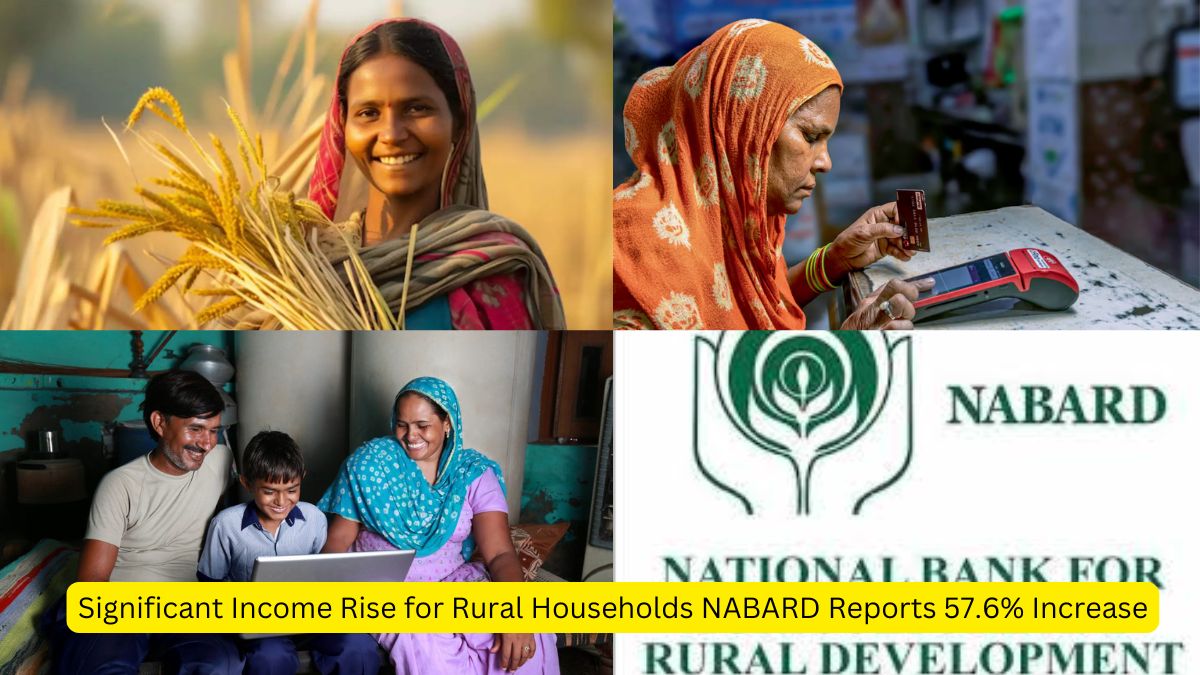A recent survey by the National Bank for Agriculture and Rural Development (NABARD) highlights a remarkable increase in the average monthly income of rural households, which rose by 57.6% over the past five years. The second ‘All India Rural Financial Inclusion Survey (NAFIS) 2021-22’ reports that the average monthly income grew from ₹8,059 in 2016-17 to ₹12,698 in 2021-22, indicating a compound annual growth rate (CAGR) of 9.5%.
Key Findings
Income Growth
- The average monthly income of rural households increased by 57.6%, from ₹8,059 in 2016-17 to ₹12,698 in 2021-22.
- This growth corresponds to a nominal CAGR of 9.5%.
Financial Savings Improvement
- Average annual savings in rural households rose to ₹13,209 in 2021-22, up from ₹9,104 five years earlier.
- The percentage of households reporting savings increased to 66% in 2021-22, compared to 50.6% in 2016-17.
Outstanding Debt Trends
- The proportion of households with outstanding debt rose from 47.4% to 52%, indicating increased reliance on loans.
Insurance Coverage Increase
- Households with at least one insured member surged from 25.5% in 2016-17 to 80.3% in 2021-22, reflecting better access to financial services post-COVID-19.
Expenditure Patterns
- Average monthly expenditures grew from ₹6,646 in 2016-17 to ₹11,262 in 2021-22.
- The share of food in total consumption declined from 51% to 47%, suggesting a shift towards diverse spending needs.
Institutional Borrowing Rise
- Institutional borrowing among agricultural households increased to 75.5% in 2021-22, up from 60.5% in 2016-17.
- Conversely, non-institutional borrowing decreased from 30.3% to 23.4%.
KCC Effectiveness
- The Kisan Credit Card (KCC) program has significantly expanded financial inclusion among rural farmers, making access to credit easier.
Pension Coverage Improvement
- Pension coverage among households increased from 18.9% to 23.5%, enhancing social security for rural families.
Financial Literacy and Behavior
- The survey revealed improvements in financial literacy and better financial behaviors among respondents, which may contribute to increased savings and reduced reliance on non-institutional loans.
Decline in Landholdings
- Despite the growth in income and savings, the average size of landholdings decreased from 1.08 hectares to 0.74 hectares over the five-year period.
About CAGR
- The compound annual growth rate is, also known as (CAGR) is the annual growth of your assets over a certain period.
- In other words, we can define compound interest growth rate as to how much returns could be earned on their investments in a given period of time.
- It also renders a stable rate of return over the period.
- The compound annual growth rate is especially useful for analyzing growth rates from various data sets of the same domain, such as the revenue growth of companies in the same field or sector.
- It is also the most precise and accurate way to calculate or determine results for individual assets, portfolios for investments, or anything that can fall or rise over the value of time.
KCC Scheme
- The scheme was introduced in 1998 for providing adequate and timely credit support from the banking system, under a single window with flexible and simplified procedure to the farmers for their cultivation and other needs like purchase of agriculture inputs such as seeds, fertilizers, pesticides etc. and to draw cash for their production needs.
- The scheme was further extended for the investment credit requirement of farmers viz. allied and non-farm activities in the year 2004.
- In the Budget-2018-19, government announced the extension of the facility of Kisan Credit Card (KCC) to fisheries and animal husbandry farmers to help them to meet their working capital needs.
NABARD
- NABARD is India’s apex development bank, established in 1982 under an Act of Parliament to promote sustainable and equitable agriculture and rural development.
- In its journey of more than four decades, the premier development financial institution has transformed lives in Indian villages through agri-finance, infrastructure development, banking technology, promotion of microfinance and rural entrepreneurship through SHGs & JLGs and more.
- It continues to aid in nation building through participative financial and non-financial interventions, innovations, technology and institutional development in rural areas.
Vision
- Development Bank of the Nation for Fostering Rural Prosperity
Mission
- Promote sustainable and equitable agriculture and rural development through participative financial and non-financial interventions, innovations, technology and institutional development for securing prosperity.
| Summary/Static | Details |
| Why in the news? | A recent survey by the National Bank for Agriculture and Rural Development (NABARD) highlights a remarkable increase in the average monthly income of rural households, which rose by 57.6% over the past five years. |
| Financial Savings Improvement | – Average annual savings rose to ₹13,209 from ₹9,104.
– Percentage of households with savings increased to 66% from 50.6%. |
| Outstanding Debt Trends | – Proportion of households with debt increased from 47.4% to 52%, indicating higher loan reliance. |
| Insurance Coverage Increase | – Households with at least one insured member surged from 25.5% to 80.3% |
| Expenditure Patterns | – Average monthly expenditures grew from ₹6,646 to ₹11,262.
– The share of food in total consumption decreased from 51% to 47%. |
| Institutional Borrowing Rise | – Institutional borrowing for agricultural households rose to 75.5% from 60.5%.
– Non-institutional borrowing decreased from 30.3% to 23.4%. |
| NABARD Overview | – NABARD was established in 1982 to promote sustainable agriculture and rural development.
– Focuses on agri-finance, infrastructure, microfinance, and rural entrepreneurship. |




 Deepinder Goyal Tops Hurun Rich List 202...
Deepinder Goyal Tops Hurun Rich List 202...
 BofA Report: India Tops Global Charts in...
BofA Report: India Tops Global Charts in...
 Coffee Plantation in India: Global Rank,...
Coffee Plantation in India: Global Rank,...







